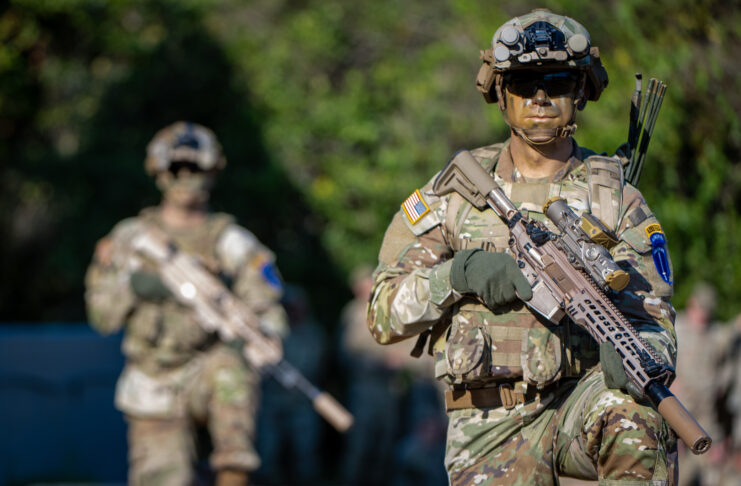
ANALYSIS – The Army is getting new guns. Well, at least new rifles. As I’ve written before, Sig Sauer won the competition in 2022 to field the new XM7 Rifle and XM250 Automatic Rifle combination to replace the M4A1 Carbine and M249 Squad Automatic Weapon within the next decade.
Both new weapons use the highly touted, fresh new 6.8mm round.
The Marine Corps and Special Operations Command (SOCOM) were also included in the years-long testing and development and will have the option to adopt the new-caliber weapons.
Both new weapons use the highly touted, fresh new 6.8mm round.
The Marine Corps and Special Operations Command (SOCOM) were also included in the years-long testing and development and will have the option to adopt the new-caliber weapons.
NextGen tests in extreme conditions
The new guns, with the new ammo, should allow users to shoot farther, faster, more accurately and hence more lethally than the two legacy weapons chambered in 5.56mm.
The program is known as the Next Generation Squad Weapons (NGSW). And now the Army is going to be testing them in extreme conditions this summer.
According to a Tuesday press release, these conditions will range from hot and cold to mud and “salt fog.” The release added that the new guns are expected to undergo airborne testing sometime next year.
In addition to those extreme environment tests, the Army will test the weapons’ ability to handle malfunctions and blank firing in what the service is calling Production Qualification Testing, or PQT.
Meanwhile, the rifles will continue to trickle out to line units.
While the new two weapons have gotten generally good performance reviews, especially among special operators, some aren’t so sure about one of them.
And the new, heavier round is part of the reason. Overall weight is the other.
As Miliary.com reports:
One former 75th Ranger Regiment officer told Military.com that the XM250 “is a welcome replacement to the outdated and largely unreliable M249. It’s lighter, more accurate, and uses a far superior round.”
But the weapons aren’t perfect, and the continued testing, especially the extreme environmental assessments that will occur between May and July, will likely show where those flaws may lie.
“The [XM7] is incredible in terms of its features and capabilities, but it’s too heavy, and too large right now to be a standard infantry rifle,” said the former Ranger officer, who was granted anonymity out of concern that talking to the media might impact professional prospects.
The fielding brings new ammo, as well. The lighter 5.56mm will be replaced with a heavier 6.8mm round. The additional weight, though seemingly minimal, adds up for grunts carrying it and a heavier weapon over long distances.
Referring to the XM7 Rifle intended to replace the M4, the former Ranger officer said, “I see it [as] more of a designated marksman rifle [rather] than a standard issue combat rifle.”
He added: “The new round is amazing performance-wise, but the average soldier can’t carry nearly as many rounds compared to the 5.56.”
Dr. Allan Orr, a strategic studies specialist who focuses on asymmetric warfare, has made a far more scathing review of the entire NGSW program.
Writing in the Army Times in February, Orr notes:
On all key technical measures, the Next Generation Squad Weapons program is imploding before Army’s very eyes. The program is on mechanical life support, with its progenitors at the Joint Chiefs obstinately now ramming the program through despite spectacularly failing multiple civilian-sector peer reviews almost immediately upon commercial release.
Orr also notes the new rifles’ operating system, saying: “Possibly aiming to avoid long-term health and safety issues associated with rifle gas, Army has selected an operating system less hardy in battlefield environments.”
He adds:
Civilian testing, testing Army either never did or is hiding, also only recently demonstrated that the rifle seemingly fails, at point-blank ranges, to meet its base criteria of penetrating Level 4 body armor (unassisted)… Of course, the rounds can penetrate body armor with Armor Piercing rounds, but so can 7.62x51mm NATO, even 5.56x45mm NATO.
While the Army never explicitly set this goal, it has insinuated to everyone, from the media to Congress, that this was a reason for the new weapons.
“The fundamental problem with the program,” Orr explains, “is there remains not enough tungsten available from China, as Army knows, to make the goal of making every round armor piercing even remotely feasible.”
Of course, relying on China for critical minerals for U.S. military purposes should be the biggest problem.
Orr also takes aim (pun intended) at the new sight chosen for the rifles.
He writes:
The Vortex XM-157, which may have critical components made in China, is most definitely not an ‘auto-aiming’ sight. For guaranteed hits, the shooter still must manually ‘ping’ the target. This takes back usable seconds and makes shooting 100% accurately on the fly, as envisioned under the program to justify the reduced available round count, an utter pipe dream. The scope is otherwise a normal scope.
Orr concludes: “Starting from a highly dubious intellectual, strategic and tactical baseline, the NGSW program is now failing mechanically and ballistically at once.”
So, now let’s see what the ‘extreme’ conditions testing and PQT will show us. And let’s see if the Army is honest about the results.
By Paul Crespo March 17, 2023. American Liberty News. Reproduced with permission.
